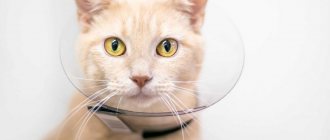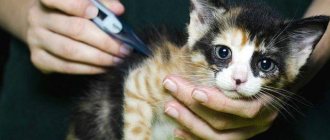It is believed that cats, unlike cats, are more affectionate, social and aimed at communicating with people. This is all true, exactly before the start of estrus. At this moment, even the most patient owners want to run away somewhere, just not to hear these inviting cries and loud meows.
Sterilization, an operation to completely or partially remove reproductive organs, can provide a quiet life for both owners and pets. The body stops producing sex hormones, reproductive function ceases and the animal no longer experiences the call of the flesh, the reproductive instinct subsides. Sterilized animals are much less likely to run away from home and also have a calmer and more docile character.
If you only dreamed of a pet friend, and do not want to participate in breeding, pregnancy, childbirth and the placement of kittens, then the most reasonable solution in this case would be sterilization. You can find out how much it costs to sterilize cats in St. Petersburg on the clinic’s website, and in the article we will tell you in detail about the types and methods of the procedure, how to prepare the animal and how to care for it afterwards.
Why sterilize your cat?
Sterilization helps reduce or eliminate an animal's sexual activity. After this procedure, cats are not subject to hormonal surges, behave calmer and do not rush outside in search of a partner.
Sterilization will help avoid many health problems. IgorVetushko/depositphotos.com
This also brings certain benefits to the cat’s body. After all, if estrus passes without mating, diseases of the reproductive organs may develop, such as inflammation of the uterus (pyometra), or problems with the mammary glands and ovaries may begin. According to Banfield research: Spaying, neutering correlates with longer lives, animals that have been sterilized live longer.
This operation is also a reliable way to avoid the appearance of kittens, which are then not so easy to place. And for pets who spend time outside unattended, this is also protection from diseases that can be contracted from non-domestic animals.
When is a Scottish cat neutered?
Veterinarians give clear advice at what age to castrate Scottish kittens - as soon as possible after birth, approximately 10-12 months. This is the optimal age for the operation, when the animal is considered sexually mature, hormones in the body have played a role in development, so there are no contraindications to castration of a Scottish fold cat. The main thing is that the cat is healthy and is examined by a veterinarian.
If a cat is neutered after the experience of mating with a cat, then he may retain the mating process, as well as intuitive memory and behavior.
A Scotsman can and should be castrated at any age, but preferably before the age of 5, when he does not have age-related diseases.
The cost of castration surgery varies depending on the region of the Russian Federation, as well as where it is performed. Calling a veterinarian to your home is convenient for the owner and the cat, but is complicated by special preparations for the site for surgical procedures.
Table No. 1 Approximate cost of castration of cats in different cities of the Russian Federation.
Why do they castrate?
Many people choose a Scottish fold or straight-eared kitten for the soul, because of their love for this breed of cat. Often, breeders themselves neuter pet-class kittens with slight deviations from the standard before sale. This is especially true for Scottish Folds, who are susceptible to genetic diseases due to improper mating.
Unsterilized cats, in the absence of mating, mark the space with stinking urine, during sexual behavior they loudly make terrible sounds and show aggression, which forces the owner to resort to castration surgery.
A conventional operation (orchiectomy), when the testicle in the scrotum needs to be removed, goes quickly. It only takes 15 minutes for the veterinarian to make one small incision, remove the testes, and return the pet to the owner.
Minor complications can arise when you need to castrate, and the kitten is diagnosed with cryptorchidism:
- the ovary-testis is not descended into the scrotum:
- the ovary-testis is located outside the scrotum;
- the ovary-testis is incorrectly located, under the skin in the groin or perineum.
In case of such deviations, the “cryptorchus” operation can be performed in the following ways:
The open method requires surgical intervention with an incision in the place where the ovary-testis is found:
- A more gentle intervention using a puncture, through which the doctor performs all manipulations to remove the ovary and testis.
- Scottish cats should not be fed 5 hours before the operation, because it is performed under anesthesia, and the animal may vomit.
Pet after castration
The entire postoperative period for both straight-eared and fold-eared kittens will last several days and pass without complications. The Scottish cat will need special care on the first day when he recovers from anesthesia:
- be sure to place a sanitary napkin under it; if it is weakened, it may not reach the tray;
- provide a warm place; after surgery, the cat’s internal heat exchange is disrupted;
- Do not place the cat in high places so that it does not fall;
- do not force him to eat, but place him next to a container of water.
After recovering from anesthesia, a well-rested pet will behave as usual. It is important to make sure that he does not lick the incision site. To do this, a postoperative collar is put on him. The wound is treated with an antiseptic for several days.
What are the types of cat sterilization?
Surgeries to terminate reproductive function and remove the organs responsible for it in cats are different.
- Ovariectomy - removal of only the ovaries, leaving the uterus untouched. Suitable for young animals, as well as cats who have not yet had kittens.
- Hysterectomy - removal of the uterus while preserving the ovaries. Applicable only in individual cases for medical reasons. After this operation, estrus and behavior corresponding to this period are maintained.
- Ovariohysterectomy is the removal of all reproductive organs, that is, the ovaries and uterus. Suitable for adults and cats who have already given birth, as well as those with pathological changes in the uterus.
The surgical procedure is performed in several ways:
- an incision along the white line, that is, on the belly;
- side cut;
- ultra-small incision using a surgical hook;
- laparoscopy, that is, removal through small incisions (punctures) using endoscopic equipment.
The appropriate option is determined by the veterinarian based on the characteristics of the operation and the animal’s body.
Another method is tubal occlusion, that is, ligation of the fallopian tubes. The reproductive organs are not removed during this operation. Moreover, the cat completely retains its previous behavior and even goes into heat. But the pet cannot get pregnant. An additional risk associated with this operation is the formation of tumors and cysts in the ovaries and uterus.
Cats are also chemically sterilized, which is temporary. In this case, surgery is not necessary; the animal is simply injected with a drug that for a certain time reduces the production of hormones and suppresses sexual activity. This option is suitable if you need to get healthy offspring from your pet, but after some time.
Take care and follow up: features of preparation and care
Even if you miss the moment and the cat chews the stitches, disaster will not happen - at least that’s what doctors convince. The incision made by the veterinarian is about 1 centimeter. If it is necessary to remove the uterus, it is dilated, but if this reproductive organ is healthy, this is not necessary.
photo from the site: Simple-fauna.ru
The owner should remember that the operation cannot be performed during estrus - the cat may lose a lot of blood. If a mature egg reaches the peritoneum, reproduction will begin. The result will be continuous estrus - a nightmare for both the animal and its owners. The same scenario is possible if the veterinarian does not completely remove the ovary. The way out of the situation is to constantly use hormonal contraceptives. Treatment for life is a real punishment for your pet and you, so prepare for sterilization, taking into account all the features of this procedure.
What to do before sterilizing a cat
The operation can be performed in a veterinary clinic or at home. But in any case, some preparation will be required. First, your cat needs to be vaccinated against infectious diseases. It is placed no later than 4 weeks before the procedure. It is also advisable to deworm the animal in about a week or two.
Do all the tests to make sure that the operation will not harm you. ilariya.95.mail.ru/depositphotos.com
Before sterilization, also be sure to consult with a veterinarian, go through all the tests that are prescribed, and get tested. This will help avoid complications, because surgery for problems with the lungs, heart or other organs can harm the body and lead to dire consequences. This is especially true for animals over 10 years old.
If all indicators are normal, the veterinarian will prescribe surgery. The pet should not be fed 12 hours before the procedure to avoid vomiting during and after anesthesia. It is better to stop giving water about 2 hours before anesthesia.
A blanket will help keep the seams clean. Ukususha/depositphotos.com
You also need to buy a special blanket in advance that will fit the size of the animal. It is put on immediately after surgery and prevents the cat from licking the wound, and also protects from dirt and damage.
Features of sterilization of British and Scottish breeds
Experts recommend sterilizing British and Scottish cats between the ages of 8 and 12 months. This is due to the fact that at this age the animal reaches puberty, and the body is sufficiently developed to normally withstand the operation and undergo anesthesia.
In addition, British and Scottish women mature a little later than their relatives, but sterilization in the early period avoids the psychological factor. Cats after removal of the uterus and appendages may begin to show signs of sexual heat. This is due to the fact that after removal of the genital organs, the pituitary gland can completely take over the function of producing hormones. Therefore, if sterilization is not timely, the owner may not get rid of the cat’s annoying behavior.
Particular attention must be paid to the nutrition of these breeds. They have a predisposition to large weight gain, and after surgery, obesity in these cats occurs very quickly. In order to avoid obesity in a cat, it is recommended to consult with a veterinarian on the preparation of the correct diet, as well as to ensure as much active exercise as possible so that the animal uses up reserves energy
When purchasing a kitten or an adult, the owner must determine a goal for himself. The cat can be purchased for further breeding and offspring. In such cases, you need to understand the responsibility for the fate of the kittens when they are born and grow up.
In another case, a cat is purchased simply to become a loyal friend and pet, and expecting offspring is not included in the plans. It is recommended to immediately ensure that the cat is sterilized, because by using medications and contraceptives for animals, the owner dooms the animal to torment and suffering. Often the consequence of the use of drugs that reduce sexual desire is the development of dangerous diseases and death.
What care does a cat need after sterilization?
After surgery in the clinic, transport the animal in a carrier with a hard bottom, covered with a diaper or towel. During the cold season, take care that your pet does not freeze, because after anesthesia her body temperature is already lowered.
How to care for a cat in the first hours
When you bring your pet home, put it on a bed, towel or blanket and cover it if it’s cool. The same should be done if the operation took place at home.
Do not place the animal on a sofa or other elevated surfaces, because after waking up from sleep it will not immediately return to its normal state and may fall. It is advisable that there are no sharp corners or other surfaces nearby that could easily cause injury. If the room is cold, take care of additional heating. But do not place your pet directly next to a radiator or heater.
Help your cat recover calmly after surgery./depositphotos.com
Do not allow small children near your pet at first, so that they do not accidentally harm her. If there are other animals in the house, it is also better to isolate them from the sterilized patient.
When the cat comes to, do not leave it unattended. While the anesthesia is in effect and the pet’s eyes are open (they do not close under the influence of the drugs), periodically instill saline or boiled water into them until the animal begins to blink on its own. This will prevent the cornea from drying out, and getting out of sleep will be more comfortable.
How to care for a cat when she's awake
Having returned to consciousness, the animal will move uncertainly, stagger, and perhaps even fall for several hours. The cat may also show aggression, bite and hiss, try to climb somewhere or hide in a secluded place. At this time, under no circumstances should she be left alone. After all, acting unconsciously, your pet can simply harm itself.
If your pet is too active and does not calm down, you can even close it in a carrier to keep it safe. After some time, the cat will fully come to its senses - when exactly depends on the characteristics of the body.
Best age for sterilization
The period of puberty in cats differs from other pets. Once a cat reaches 6-9 months of age, it is considered fully sexually mature and can bear viable offspring.
In some cat breeds, due to the characteristics of the body, puberty occurs slightly earlier - at the age of 4.5 - 6 months. This period is characterized by the active release of hormonal substances of the sexual type into the bloodstream - estrogens (produced by the ovaries). Under the influence of a specific hormone, a condition arises that the cat causes anxiety to its owner - it begins to scream heart-rendingly and demand a male, trying to escape from the house.
What medications should I give my cat after sterilization?
Your veterinarian may recommend giving your animal antibiotics. But you shouldn’t do this without a doctor’s recommendations, much less use ordinary, “human” drugs, as this can harm your pet.
If you doubt that your cat is feeling well, consult your doctor. Motortion Films / shutterstock.com
In some cases, additional processing of the seams may be necessary. The specialists who operated will explain how to do this correctly and whether it is necessary. If this is not required, simply inspect the seams every day to make sure they are dry and clean. In case of suppuration, it is better to immediately contact the clinic.
If you doubt that you will be able to provide the necessary care, or simply do not have time for this, after the operation the cat can be left in the hospital, where veterinarians will look after it.
Nutrition for a neutered cat
After surgery, there is no need to radically change the animal's diet .
If your cat has been eating dry food, pay attention to food for sterilized animals from the same company. Natural nutrition should be complete : contain proteins, fats and carbohydrates. The only thing that needs to be excluded from the diet is fish.
It contains too much magnesium and phosphorus, which can provoke the development of urolithiasis.
It is worth monitoring the animal’s weight more closely; neutered cats are prone to overeating . The portion size may need to be reduced a little.
Sterilization is a safe operation . It not only makes it possible for a domestic cat to live a full life without emotional overload, but also significantly reduces the risk of developing serious diseases .
Can I be spayed during estrus, pregnancy, nursing or after childbirth?
Estrus is not a reason for refusal to sterilize - the cat will easily tolerate anesthesia, and hormonal disorders will not affect the animal's body.
Another thing is during pregnancy or after childbirth. The following factors need to be examined here:
- During pregnancy, not sterilization is possible, but castration - removal of all genital and reproductive organs. This is explained by an enlarged uterus, in which the size of the blood vessels increases. The same applies to the fallopian tubes. As a result of the operation, the veterinarian risks damaging the ovaries and causing heavy blood loss, so specialists only undertake castration during pregnancy.
- After giving birth, a cat is sterilized only at a certain time. If a young mother is breastfeeding, she will have to wait until the end of the lactation period. If there is no litter, then it is enough to wait 3-4 weeks - during this time the uterus will return to its previous size.
- Sterilization is not carried out while feeding offspring due to the risk of injury to the mammary glands with subsequent infection of the wound.
From the above, it becomes clear that the most appropriate time to sterilize a cat is during estrus or after it ends.











